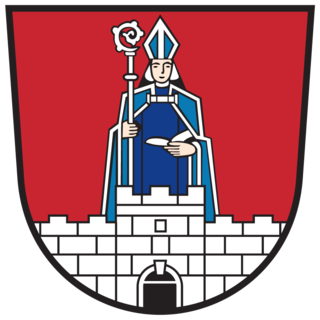
Amiternum was an ancient Sabine city, then Roman city and later bishopric and Latin catholic titular see in the central Abruzzo region of modern Italy, located 9 km (5.6 mi) from L'Aquila. Amiternum was the birthplace of the historian Sallust.

Bettona is an ancient town and comune of Italy, in the province of Perugia in central Umbria at the northern edge of the Colli Martani range. It is 5 km (3 mi) E of Torgiano and 12 km (7 mi) SW of Assisi.

Novalja is a town in the north of the island of Pag in the Croatian part of Adriatic Sea. In recent times, Novalja has become famous because of the Zrće Beach.
Aveia was an ancient town of the Vestini and Roman former bishopric, which remains a Latin Catholic titular see.

Gnatia, Egnatia or Ignatia was an Ancient city of the Messapii, and their frontier town towards the Salentini. As Egnazia Appula it was a medieval bishopric, which remains a Latin Catholic titular see.

Orte is a town, comune, former Catholic bishopric and Latin titular see in the province of Viterbo, in the central Italian region of Lazio, located about 60 kilometres (37 mi) north of Rome and about 24 kilometres (15 mi) east of Viterbo.

Zuglio is a comune (municipality), former bishopric and Latin Catholic titular see in the Province of Udine in the northeastern Italian autonomous region Friuli-Venezia Giulia, located about 110 kilometres (68 mi) northwest of Trieste and about 45 kilometres (28 mi) northwest of Udine in the Val Bût.

Brescello is a comune (municipality) in the Province of Reggio Emilia in the Italian region Emilia-Romagna, located about 80 kilometres (50 mi) northwest of Bologna and about 25 kilometres (16 mi) northwest of Reggio Emilia. As of 31 December 2016, it had a population of 5,621.

Bagnoregio is a comune (municipality) in the Province of Viterbo in the Italian region of Lazio, located about 90 kilometres (56 mi) northwest of Rome and about 28 kilometres (17 mi) north of Viterbo.

Arpaia is a town, comune (municipality) and former episcopal see in the Province of Benevento in the southern Italian region Campania, located about 35 km northeast of Naples and about 25 km southwest of Benevento.
Caudium was the main city of the ancient Caudini tribe in Samnium situated on the Appian Way between Beneventum to Capua. It or nearby Arpaia became the seat of an early bishopric, which is now a Latin Catholic titular see under both (synonymous) names.

Paternian or Paternianus is the name of an Italian saint. A native of Fermo who escaped to the mountains during the persecutions of Christians by Diocletian, he was then appointed bishop of Fano by Pope Sylvester I.
Saint Terentian(us) was Bishop of Todi who was killed during the reign of Hadrian (117–138).
San Giovanni Profiamma is a civil parish in the municipality of Foligno in the province of Perugia, which is also an active bishopric, and is the historical site of the former Roman town and bishopric of Foro Flaminii, which remains a Latin Catholic titular see as Foro Flaminio. It is in the circoscrizione no. 6: San Giovanni Profiamma-Belfiore-Vescia-Capodacqua-Pontecentesimo.

Passo Corese is an Italian town and hamlet (frazione) of Fara in Sabina, a municipality in the province of Rieti, Lazio. In 2011 it had a population of 3,573.

The Mausoleum of Helena is an ancient building in Rome, Italy, located on the Via Casilina, corresponding to the 3rd mile of the ancient Via Labicana. It was built by the Roman emperor Constantine I between 326 and 330, originally as a tomb for himself, but later assigned to his mother, Helena, who died in 330.

Claternae, also called Claterna, was a Roman town on the Via Emilia situated between the coloniae of Bononia and Forum Cornelii. Like many other evenly spaced settlements on the Via Emilia, each at a day's march for the legionaries, it probably arose as a stopping place for travellers between the major towns.
Cediae (Cediæ) was an ancient city and former bishopric in Roman North Africa. It is now a Latin Catholic titular see.
The Roman Catholic Diocese of Sant’Angelo in Vado is a suppressed diocese in Italy which is now part of the Archdiocese of Urbino–Urbania–Sant’Angelo in Vado.
The Diocese of Lilybaeum was a diocese of the Roman Catholic church until the 9th century, when it was suppressed. It was revived as a titular see in 1966.












